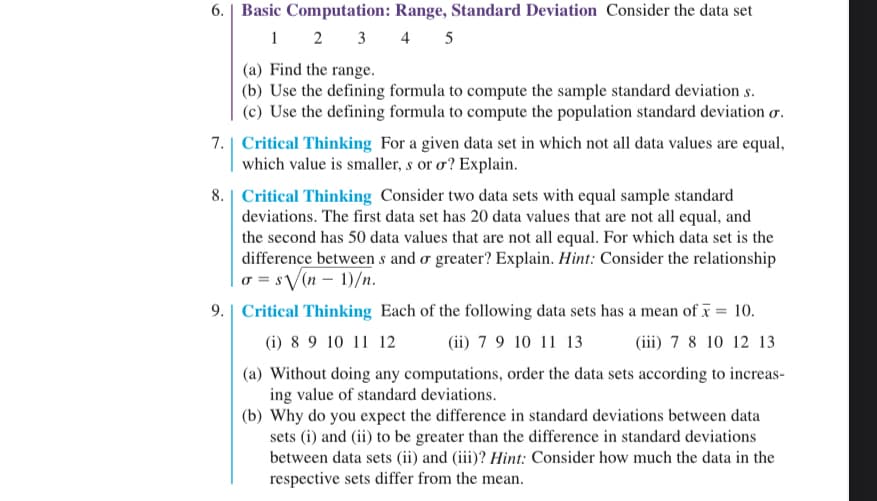Please answer number 9. All steps!! Make sure to show work!! Answer quickly!
Glencoe Algebra 1, Student Edition, 9780079039897, 0079039898, 2018
18th Edition
ISBN:9780079039897
Author:Carter
Publisher:Carter
Chapter10: Statistics
Section10.3: Measures Of Spread
Problem 26PFA
Related questions
Question
Please answer number 9. All steps!! Make sure to show work!! Answer quickly!

Transcribed Image Text:6. Basic Computation: Range, Standard Deviation Consider the data set
1
4 5
2 3
(a) Find the range.
(b) Use the defining formula to compute the sample standard deviation s.
(c) Use the defining formula to compute the population standard deviation o.
7. Which value is ng for a given dap set in which not all data values are equal,
smaller, s or o? Explain.
8. Critical Thinking Consider two data sets with equal sample standard
deviations. The first data set has 20 data values that are not all equal, and
the second has 50 data values that are not all equal. For which data set is the
difference between s and a greater? Explain. Hint: Consider the relationship
a = sVn − 1)/n.
9. | Critical Thinking Each of the following data sets has a mean of x = 10.
(i) 8 9 10 11 12
(ii) 7 9 10 11 13
(iii) 7 8 10 12 13
(a) Without doing any computations, order the data sets according to increas-
ing value of standard deviations.
(b) Why do you expect the difference in standard deviations between data
sets (i) and (ii) to be greater than the difference in standard deviations
between data sets (ii) and (iii)? Hint: Consider how much the data in the
respective sets differ from the mean.
Expert Solution
This question has been solved!
Explore an expertly crafted, step-by-step solution for a thorough understanding of key concepts.
Step by step
Solved in 4 steps with 2 images

Recommended textbooks for you

Glencoe Algebra 1, Student Edition, 9780079039897…
Algebra
ISBN:
9780079039897
Author:
Carter
Publisher:
McGraw Hill

Glencoe Algebra 1, Student Edition, 9780079039897…
Algebra
ISBN:
9780079039897
Author:
Carter
Publisher:
McGraw Hill